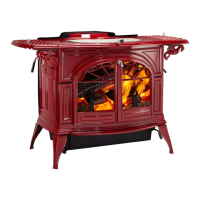
Do you have a question about the Vermont Castings Defiant 1610 and is the answer not in the manual?
| Brand | Vermont Castings |
|---|---|
| Model | Defiant 1610 |
| Category | Wood stove |
| Language | English |
Detailed specifications including emissions, heat output, dimensions, and fuel capacity for the Defiant Model 1610.
Diagram illustrating the physical dimensions and measurements of the Defiant NC stove.
Crucial safety warnings and requirements before installing the Defiant stove to prevent fire hazards.
Guidance on connecting an outside air supply for optimal combustion in modern homes.
Information on recommended chimney heights based on altitude for proper stove draft.
Details on approved chimney types: masonry and prefabricated, and inspection requirements.
Requirements for masonry chimneys, including lining, condition, and cleaning before use.
Standards for prefabricated metal chimneys used with solid-fuel appliances.
Matching chimney flue size to stove outlet for optimal draft and performance.
Instructions for assembling and installing single-wall chimney connectors with appropriate clearances.
Procedure for securely connecting the chimney connector to a prefabricated chimney system.
Methods for connecting the chimney connector to masonry chimneys, including thimble use.
Guidance for connecting the stove's chimney connector to the chimney above a fireplace opening.
Instructions for installing the stove through the fireplace opening using a positive connection kit.
Approved methods for passing chimney connectors through combustible walls in the US.
Guidelines for passing chimney connectors through combustible walls in Canada.
Specific dimensions for floor protection extending from the stove front, sides, and rear in the US.
Specific dimensions for floor protection extending from the stove front, sides, and rear in Canada.
Procedure to determine the acceptability of alternative noncombustible floor protection materials.
Methods to reduce clearance requirements using wall shields and other protective measures.
Guidelines for constructing and installing ventilated wall shields to reduce clearances.
Specific requirements for shields around fireplaces and mantels to maintain safe clearances.
Table detailing required clearances for the stove based on surface protection and installation type.
Table detailing required clearances for the chimney connector based on protection and type.
Table detailing required clearances for the stove based on surface protection and installation type.
Table detailing required clearances for the chimney connector based on protection and type.
Visual representations of required clearances for various installation scenarios and connection sizes.
Tables showing required distances from the flue collar center to walls for 6" connections.
Tables showing required distances from the flue collar center to walls for 8" connections.
Instructions for moving and preparing the stove for installation.
Guidance on how to properly store the removable door handle when not in use.
Steps for attaching the stove legs to the stove body.
Procedure for attaching the bottom heat shield, crucial for most installations.
Instructions for installing the optional fan kit for improved heat distribution.
Explanation of the primary air control and damper for regulating fire and heat output.
Guide to adjusting the air control lever for different heat ranges and burn times.
How the damper controls airflow within the stove for updraft or efficient mode.
Methods for loading fuel, including top loading and front door loading.
Features of the glass panels for clear fire viewing and how andirons help protect them.
Recommendations for burning only seasoned, natural wood for best results and stove longevity.
Using a surface thermometer to monitor stove temperature and guide air control adjustments.
Detailed instructions for safely starting a fire with newspaper, kindling, and dry wood.
Guidance on initial break-in fires to condition the stove and manage initial odors.
Procedure for adding wood to a hot stove to maintain an ember bed and ensure efficient burning.
Critical warnings about door operation, overfiring, and keeping children/materials away.
Step-by-step guide for safely removing and disposing of ash from the stove's ash pan.
Guidelines for storing ash in metal containers outdoors and using wood ash as fertilizer.
Explanation of how natural draft works and factors affecting stove performance.
Comparison of masonry and steel chimneys regarding heat retention and draft.
How chimney height and flue size impact draft strength and creosote formation.
Optimal layout for stovepipe and chimney to ensure good draft and long-term flexibility.
Managing single venting, creosote prevention, and impact of fuel quality on draft.
Identifying and resolving back-puffing issues and performing draft tests.
Solutions for negative pressure in homes affecting stove draft, including outside air kits.
Tips for maintaining the cast iron and porcelain enamel surfaces of the stove.
Procedure for cleaning carbon deposits from the glass panels to prevent etching.
Instructions for safely replacing damaged glass panels with correct parts.
How to adjust the damper tension for a proper seal and smooth operation.
Procedure for adjusting door latches to ensure a secure and airtight closure.
Steps for replacing worn fiberglass rope gaskets on various stove parts.
Information on gaskets for non-moving parts and their unlikely need for replacement.
Importance of regular chimney inspection and cleaning to prevent serious chimney fires.
Daily checks for ash buildup and clearing airflow paths in the firebox.
Checking door handles, gaskets, and leg bolts for proper function and tightness.
Annual tasks including gasket checks, cleaning shields, and touching up paint.
Schedule for inspecting and cleaning the chimney connector and chimney system.
Diagram showing numbered parts of the Defiant Model 1610 stove.
Detailed list of stove components with corresponding part numbers.
List of shell enamel parts categorized by available colors and their part numbers.
Details of the lifetime warranty on refractory brick and EverBurn System components.
Warranty coverage for cast iron parts (3 years) and other components (1 year).
Conditions and actions that void the warranty, including misuse and improper installation.
Procedure for initiating a warranty claim, including required information and steps.


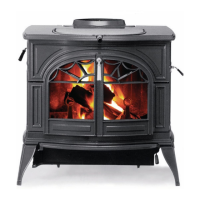
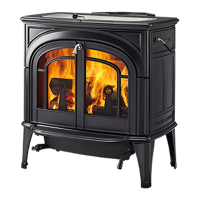
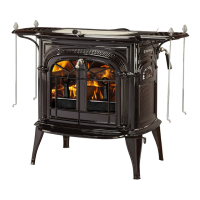

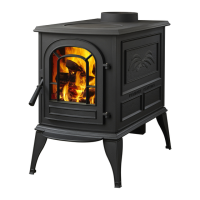
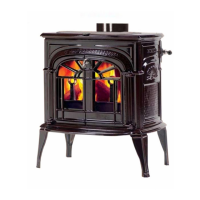
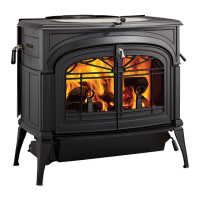
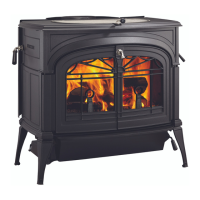

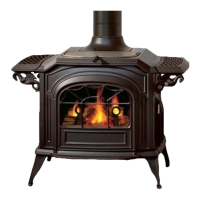
